To show this, we're going to take a couple of examples by Mozart and Haydn, and re-shuffle the surface material (the "motives") around, while retaining the original background structure (the "sketch.")
Example 1 shows a Haydn sonata opening,

familiar, no doubt, to some of you. I have labeled the "material,"
the motives, with letters. Now, the idea here is to show that any
arrangement of this motivic material can work, as long as we "tack on" the
motives to the right notes of the underlying sketch or structure,
and make a few appropriate adjustments.
We may have to alter the motives somewhat, by stretching and
shrinking their intervals, and so on, but basically they will be intact.
So, let's just pick two arrangements completely at random,
and re-compose the excerpt. I'll choose these: EDCBA, and DBECA.
The results are shown in examples 2 and 3.
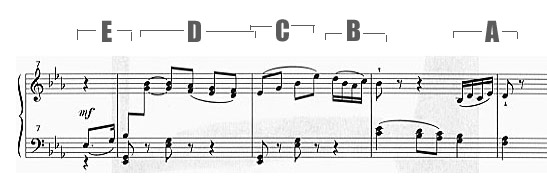
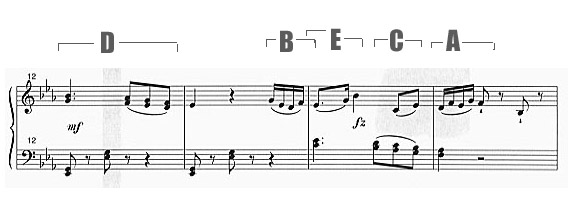
While these certainly
are not as elegant-sounding as Haydn's original,
the mere fact that they sound OK, after being so randomly
patched together, is a testament to the flexibility of the
idea of "hanging" or "tacking" motives to a background sketch:
if your background is good, and you put the motives on there
in the right way, it will work----with (with possible adjustment)
just about any material.
As a further example of this, [forgive me as] I mangle up a
Mozart sonata opening.
Example 4 shows the original,

with six motives (or in the case of F,
not a motive but a textural idea of repeating chords)
labeled. Again, we shuffle them randomly; oh, let's do:
DCCBBA on top, with
F followed by E, repeating, on the bottom. The result is shown
in example 5.
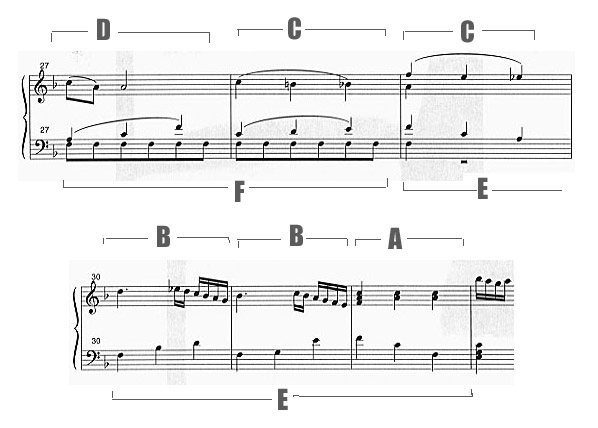
Again, not as elegant as Mozart's original, but certainly an
adequate-sounding illustration
of the flexibility I'm talking about, a flexibility which acts in the
favor of anyone who's composing.
So now, let's talk about actual composing of stuff from scratch.
In a way, the secret is simply to avoid the idea of
"from scratch." i.e.-you don't want to be in the situation of:
"OK, there's the first note; now what do I do for the second note?"
Instead, you make a sketch of the basic underlying structure of the
voice-leading,
then, you look either within the sketch
for material to "compose it out" with, or alternatively,
to the outside world.

Randomly glancing through this baby, I chose the motive bracketed as "M" for my "composing-out" material. I decided that the way I would work, at least at first, was to have one voice move about more elaborately, while the other simply plodded through the sketch tones. Then, I would do the old "switch-er-oo" and the previously plodding voice would elaborate; the previously elaborate voice, plod. That way the phrase would not be too difficult to write, but still maintain a nice balance of interest.
So I began by fooling around in my head with the motive, M,
and trying to "tack it on to" the soprano's opening C#,
against the bass voice. Adding an accented passing
tone on the end of it to lead us down to the G#, the result was bar 1.
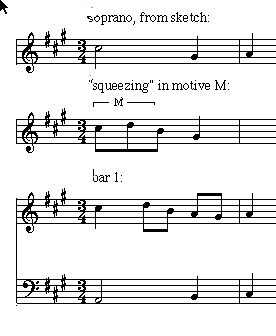
Now, I noticed that the soprano and bass voices in the sketch
exchange their materials going from the first to the second
pair of whole notes, a fact which I could take advantage of
by simply exchanging their materials for bar 2. Hence,
the simple imitation.
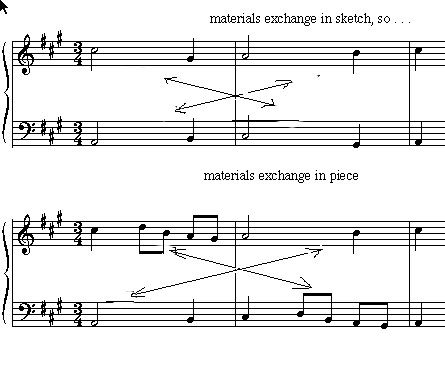
At the end of the phrase, the soprano line of the
sketch is motive M, so in order to
"elaborate" the sketch, I turned the "elaborating" material
upside-down; in other words, I turned the motive M
upside-down, and tried to see if I could fit that in somehow. The result
was bar 3's top voice---the C#-B-F# (motive M upside-down and expanded)
and then a simple descent (through D) to B.
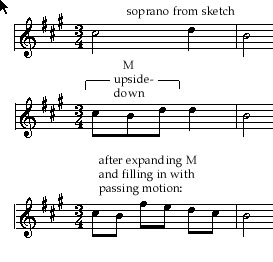
Meanwhile, in the bass voice,
as I tried to lay the motive, backwards,
onto the sketch's note-succession A-D,
I saw an opportunity for a possible suspension (from the D to the
C#). To make the suspension work, I thought
I would have to add a third voice. What would be the dissonance
on bar 3's 2nd beat that would make D in the bass into a nice suspension
into C#?
Well, E in the middle voice would be nice, but, unfortunately,
that might conflict weirdly with the soprano's F#. In the end,
the suspension turned out to be a "consonant suspension," with the F#
in the high voice.
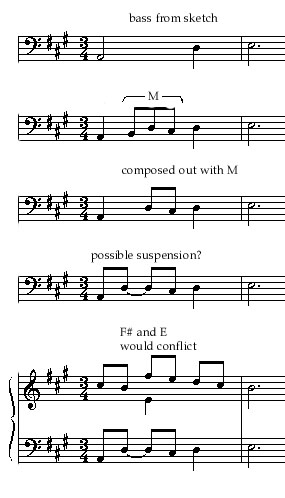
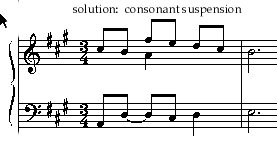
Then, working backwards in the middle voice, I thought,
OK, we want nice thick triads with root, 3rd, and 5th as much
as possible. I decided then to begin with parallel 3rds in bar 2,
which makes nice I6 and IV chords right off the bat.
The parallel
3rds create a little weirdness on the last beat of bar 2, but because
our underlying sketch is guiding everything, our ear accepts the
simultaneity A-C#-B on the last beat of bar 2 as a sort of double
accented passing tone. Note also that going into bar 3, the bass
and mid-voice form a direct motion to a fifth, but because that
occurs with an inner voice, and the outer voices are traveling in
good-ole' parallel 3rds, we accept it aurally.

The suspension in bar 3 bothered me
a bit, rhythmically. I realized that the D needed, perhaps,
more time to prepare itself. Also, the sudden extremely rapid
rhythm of all of the parts at the beginning of that bar, while
somewhat interesting, perhaps marred the flow of the passage.
So, I realized that bar 3 really wanted to be in 4/4, not 3/4.
Could I make the rest of the thing work in 4/4? It was not too hard,
and the result was the following example. I added a little fleshing out,
to fill out the additional time,
which I think you can follow quite clearly:

Example 9:

utilizes the same sketch that we used before.

This time, though, instead of "tacking on" motives drawn from
the sketch, onto the sketch; I squeezed in four (probably familiar)
quotations:
Mozart 40:

Beethoven 5:

a bit of the Star-Spangled Banner:

and finally a motive from the Police song "Message in a Bottle"
(slightly modified):

So, what was the process of composing the excerpt out of these
fragments? Well, first, I wrote down the notes of
the Mozart quote (probably because it was the longest quotation; being
the longest, it would determine what would happen to/with the shorter
quotes).

Now, we're (the sketch is) in A major, and according
to the sketch, if the Mozart quote is coming in the top voice
at the beginning, it had better feature a C# with some prominence, as
does the top voice in the sketch.
Hence, I transposed it so the beginning of it noodles around
'twixt the 3rd and 4th scale-degrees of A major (C# and D).

Now, if we let it go on in that transposition, with
the descending continuation-well, we'd be using up a lot of time,
and we've got to get the ascent shown in the sketch (G# up to D),
rather than the descent in the original motive.
So, I flipped the second half of the original tune upside down,
and lined its notes up as best I could with the notes of the sketch's
upper voice. I fiddled with it so it would give us the ending
specified in the sketch.

Then, I thought about getting the Beethoven motive in to the piece,
in the lower voice, probably towards the beginning.
In the original, the Beethoven is in c minor and is
therefore going in scale degrees: 5-5-5-3.

Here, in A major,
that would mean

However, that last C# would land on an octave with
the upper voice, in bar 1.
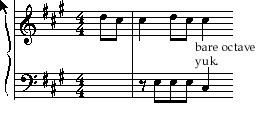
I wanted to keep my chords as rich and
harmony-full as possible, so I changed the pattern to 5-5-5-1,
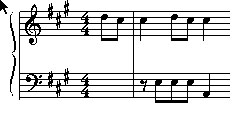
which makes a nice A-C# third on the 3rd beat of bar 1.
Later, during the second reiteration of the Beethoven motive,
when the Mozart quotation leaps to the high A, I changed
what would have been an E in the bass,
(making a bare, ugly simultanaeity of 4th) to a C#,
producing a 6th with the high voice.
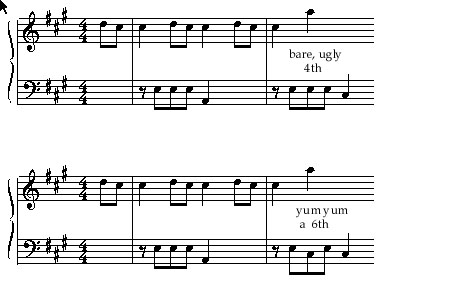
I was taking utmost care to achieve the richest, fullest
triadic harmony whenever possible.
At this point, I noticed that we're basically in the tonic chord for 1 and a half bars. That means that on beat 3 of bar 2, we're still composing out the first note of the sketch. This is an example of the interesting kinds of "fallout" that happen when working in the way(s) I am suggesting here: it makes music more interesting, in terms of pitch (would we have so easily thought of that leap to high A in the soprano without it being suggested by our "borrowed" material?) and harmonic-rhythm (would we have thought of this endless prolongation of the first sketch-notes?)
Anyway, this meant that the Star-Spangled-Banner could
probably fit right in somewhere, as it's opening 6 notes
are all in the tonic.

Again, with getting-nice-full-triads
as a desideratum, I looked around for a spot to squeeze SSB in.
The E that opens the tune (if it's in A major) fit right in with
the first strong beat articulated by both outer voices, beat 3 of
bar 1. And the rest of the opening of SSB was able to be squeezed
in successfully from there, (with the addition of some passing
motion), as you can see and hear.

At this point, the soprano's sketch tones had already been composed out,
more or less, by the Mozart quote. So now I had to fill in the bass.
What I did next, then, was to stick in the bass the notes of the
sketch's bass, underneath the appropriate notes of the high voice.

I noticed that the SSB quote, in the middle voice,
could kind of continue into bar 3,
and would be especially nice with an added passing tone between the C#
and E, hence the middle-voice D at the end of bar 2.
Finally, I looked around for somewhere to squeeze in the
Police song quotation.

Where could we put this motive, consisting of a major 3rd, followed by
a minor 2nd?
Well, in a diatonic context, it can fit as a scale-degree succession
3-1-7, or 6-4-3, and that's it, if you want the exact interval-content
of the motive preserved.
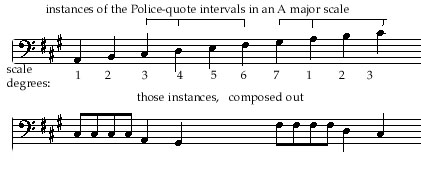
So, looking at the sketch, I saw there was a
nice little 3-7 leap in the bass, and looked to see if I could
squeeze the 3-1-7 of the quote in there.

Turned out I could,
using the A between the C# and G# as an accented passing tone.

I made one modification, to go with the
Mozart quote above, in the soprano line:
I turned one of the repeating C#'s into a B, and thus you get that
little neighboring-motion doodad in the bass on the 2nd beat of bar 3.
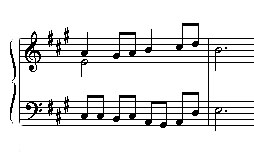
In the inner voice in bar 3, I had to abandon the end of the SSB
quotation, but that was OK, for the materials had served their purpose:
I had made something modest, but pleasant, out of my sketch.
With a little fleshing out at the cadence, I was done.

go Home.